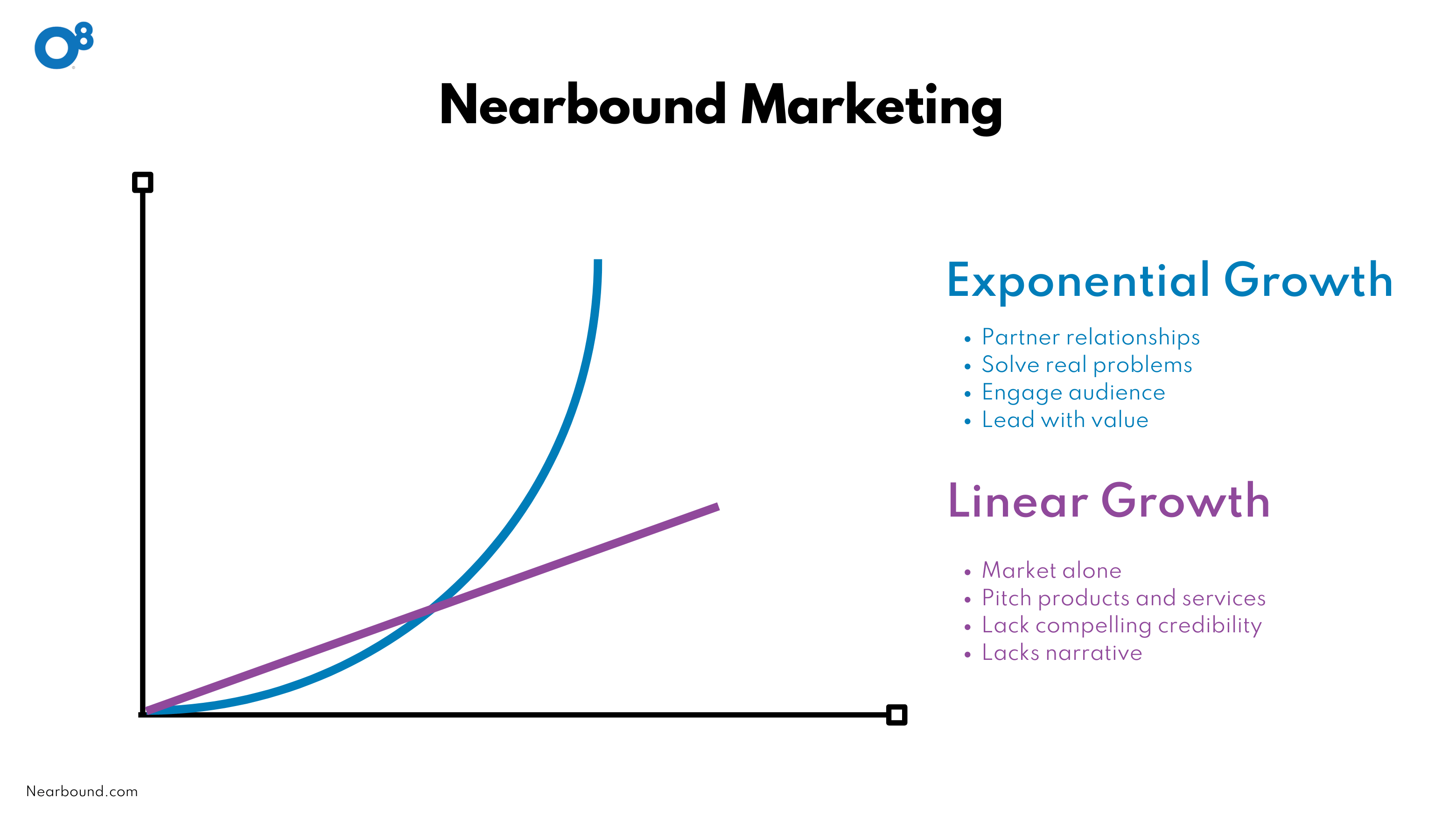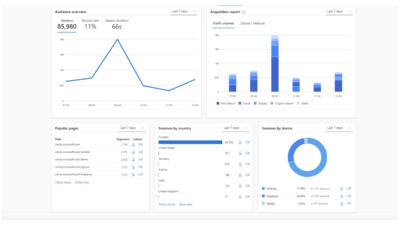Nearbound Marketing Basics: Applying Strategies to B2B Digital Marketing

In today's competitive landscape, traditional marketing methods can fall short, leading to decreased lead generation, sales, and revenue. Nearbound marketing presents a new approach, leveraging your existing network to drive revenue, growth, and success. By focusing on relationships and collaboration, your marketing team can unlock significant potential for your business without the high costs associated with outbound marketing strategies.
What Is Nearbound Marketing?
Nearbound marketing is a trust-oriented go-to-market strategy (GTM) that involves tapping into your relationships with partners, customers, and influencers to create a powerful marketing engine. At the core, It emphasizes collaboration and shared goals, allowing you to reach new audiences and build credibility through trusted connections.
Nearbound marketing is different from outbound and inbound marketing. Outbound strategies mainly include more direct contact with potential customers through various forms of media and advertising, such as cold-calling. Inbound strategy, by contrast, mainly focuses on attracting customers through informative and relevant content creation, such as podcasts, blogs, or eBooks.
In other words, Inbound and outbound cast a wider net with strategies like content marketing, while nearbound strategy is more concentrated outreach using strong relationships as the foundation. The power of nearbound lies in its ability to assist with both inbound and outbound marketing (Nearbound.com).

Key Components of a Nearbound Marketing Strategy
A nearbound marketing strategy includes multiple related forms of collaboration that work together to keep your business as connected as possible. These components all play important roles and provide your business with high-quality opportunities.
Partnerships
Nearbound marketing prioritizes successful collaboration with industry partners in a variety of ways. These include creating joint campaigns, sharing content, and promoting each other’s offerings. Effective partnerships can expand your reach and enhance your reputation. This network of partnerships is known as a partner ecosystem.
Customer Advocacy
Nearbound marketing can help you leverage satisfied customers as advocates for your brand. It is important to encourage and incentivize them to share their positive experiences, write reviews, and recommend your services to their network. This establishes that you value their input and signals trust to other prospects.
Influencer Collaboration
Nearbound marketing allows you to work with influencers who align with your brand values. They can amplify your message to a broader audience, adding trust and authenticity.
Content Sharing
As mentioned above, it is important to share valuable and credible content with your network. Providing useful, relevant information positions you as an asset and keeps your brand top-of-mind.
Turn Customers into Advocates
Discover how O8's Nearbound Strategy empowers your clients to fuel your growth.
Benefits of Nearbound Marketing
While other marketing strategies, like outbound marketing, can certainly help generate hype and lead quantity, they can be unpredictable. At times, you may struggle to keep customers interested, secure sales, and get the most for your money. Taking advantage of a nearbound marketing strategy can help resolve some of these common pain points through the following benefits:
Cost-Effective
Nearbound marketing leverages existing relationships, reducing the need for expensive ad and promotional campaigns from scratch.
Enhanced Trust
Recommendations from trusted sources, like partners or satisfied customers, build credibility and help maintain a good reputation. If your business is known for being trustworthy, more customers will be willing to utilize your services, and other businesses will be more willing to work with you.
Broader Reach
Collaborating with partners and influencers allows you to tap into their audiences, expanding your market reach. Having a larger audience that associates you with your partners and the influencers can increase the number of potential customers, qualified leads, and win rates for your sales team.
Sustainable Growth
By focusing on relationships and long-term partnerships, nearbound marketing fosters sustainable business development and growth focused on long-term results and consumer advocacy.

How to Apply Nearbound Marketing to Your B2B Strategy
Nearbound marketing has emerged as a game-changer for B2B businesses, particularly those grappling with long and complex sales cycles. This strategy leverages high-value, trust-based relationships to help key decision-makers make confident decisions and investments. Here’s a deeper dive into how you can integrate nearbound marketing into your B2B strategy.
Leverage LinkedIn for Networking
Strategy:
- Identify and Connect: Use LinkedIn to scout potential partners, influencers, and advocates within your industry.
- Engage: Share valuable content, engage with posts from your network, and participate in relevant groups.
- Build Relationships: The focus should be on nurturing these connections to foster a robust network of allies.
Why it Works:
LinkedIn is a powerful tool for building a professional network. By actively engaging, you position your brand as a thought leader and build relationships that can translate into strategic partnerships.
Develop Co-Branded Content
Strategy:
- Collaborate: Partner with influential industry players to create co-branded eBooks, whitepapers, webinars, and case studies.
- Distribute: Leverage both your and your partner’s networks to distribute the content.
- Value Creation: Ensure the content provides actionable insights and value to your shared audience.
Why it Works:
Co-branded content not only extends your reach but also enhances credibility. By associating with trusted partners, you tap into their network and reputation.
Joint Ventures and Webinars
Strategy:
- Host Joint Webinars: Collaborate with partners to host webinars or virtual events.
- Promote Collectively: Use each partner’s marketing channels to promote the event.
- Engage Audience: Focus on creating interactive and valuable sessions to ensure high engagement.
Why it Works:
Joint webinars bring together diverse audiences, increasing the potential for engagement and lead generation. They also present an opportunity to showcase combined expertise and solutions.
Customer Referral Programs
Strategy:
- Incentivize Referrals: Develop a referral program that offers meaningful rewards to your B2B customers.
- Align Rewards: Ensure the rewards are relevant to the business needs of your customers.
- Promote Program: Use email marketing, social media, and direct outreach to promote the referral program.
Why it Works:
Referral programs leverage existing customer satisfaction to generate new business. Incentives encourage customers to act as brand advocates, increasing trust and credibility.
Influencer Partnerships
Strategy:
- Identify Influencers: Look for industry influencers with a strong following among your target audience.
- Collaborate: Partner for guest blog posts, social media takeovers, or video interviews.
- Leverage Credibility: Use their influence to expand your reach and build trust with a new audience.
Why it Works:
Influencers bring their own audience and credibility. Collaborating with them can significantly amplify your brand’s reach and trust factor.
Use CRM and Marketing Automation
Strategy:
- Integrate Systems: Ensure your CRM system is integrated with marketing automation tools.
- Track and Measure: Use these tools to track interactions, measure campaign effectiveness, and nurture leads.
- Optimize Engagement: Automate workflows to streamline your marketing efforts and ensure timely follow-ups.
Why it Works:
CRM and marketing automation tools help in managing and nurturing relationships more efficiently. They enable personalized communication and track the effectiveness of your marketing strategies.
Embrace the Nearbound Marketing Approach
Strategy:
- Align with Partners: Ensure your marketing efforts are in sync with your partners.
- Unified Messaging: Maintain consistency in messaging and branding across all partner channels.
- Leverage Data: Use shared data and insights to optimize joint marketing efforts.
Why it Works:
A harmonized approach ensures that all partners are working towards the same goals, enhancing the overall impact of the marketing efforts.
Key Takeaways
- Build Trust: Trust is the cornerstone of successful nearbound marketing. Regularly engage with your partners and audience to build and maintain trust.
- Data-Driven Decisions: Use data and insights from your CRM and marketing automation tools to inform your strategies and improve results.
- Continuous Improvement: Always seek feedback and be willing to adapt your approach based on what works and what doesn’t.
For more detailed strategies and case studies on Nearbound marketing, visit Nearbound.com.
By implementing these techniques, your B2B strategy can leverage the full potential of nearbound marketing, driving more revenue through trusted relationships and collaborative efforts.
Challenges, Solutions, and Best Practices
Just like with any marketing strategy, nearbound marketing can come with an array of challenges. Fortunately, there are various ways to work through these challenges and best practices to follow that can help you sustain business growth.

Challenge 1: Identifying the Right Partners
Solution: Use data-driven analysis to identify new partners whose audience segments align with your target market. Tools like LinkedIn Sales Navigator can help identify potential partners based on industry, company size, and other criteria.
Best Practice: Regularly review and update your partner list to ensure alignment with your evolving business goals and market conditions.
Challenge 2: Ensuring Mutual Benefits
Solution: Clearly outline and communicate the benefits for all parties involved in the collaboration. Make sure that each partner has something valuable to gain.
Best Practice: Develop a win-win proposition that addresses the needs and objectives of both your business and your partners.
Challenge 3: Maintaining Consistent Communication
Solution: Establish regular in person or virtual check-ins and use collaborative tools like Slack or Microsoft Teams to maintain open lines of communication.
Best Practice: Implement a communication calendar to schedule regular updates, meetings, and progress reviews with your partners like Trello.
Challenge 4: Measuring Success
Solution: Use key performance indicators (KPIs) to track the performance of your nearbound marketing campaigns. Metrics like lead generation, conversion rates, nearbound sales, revenue growth, and customer retention rates can provide valuable insights to help refine and optimize strategies.
Best Practice: Use marketing analytics tools such as like Google Analytics, or CRM platforms like HubSpot , or Salesforce to collect and analyze data.

Challenge 5: Managing Multiple Relationships
Solution: Utilize CRM software to keep track of interactions and engagements with partners, customers, and influencers.
Best Practice: Segment your CRM database to tailor your communication and marketing efforts to different groups within your ecosystem.

Case Study: Nearbound Marketing in Action
Take this hypothetical scenario and example from ABC Tech Solutions, a mid-sized B2B software company that was struggling to generate leads and increase revenue through traditional outbound marketing strategies. They decided to pivot to a nearbound marketing approach to leverage their existing network of partners, satisfied customers, and industry influencers.
Strategy Implementation
Partnerships
ABC Tech partnered with complementary software vendors to co-host webinars and create co-branded content. This collaboration allowed both companies to share their audiences and expertise, resulting in a wider reach and higher engagement.
Customer Advocacy
The company launched a customer advocacy program, incentivizing satisfied clients to write reviews, provide testimonials, and refer new customers. They offered discounted subscription renewals and exclusive access to beta features as rewards
Influencer Collaboration
ABC Tech identified key industry influencers and engaged them to participate in product demos, guest blog posts, and social media shoutouts. These influencers provided credibility and helped reach a broader audience.
Content Sharing
Regularly sharing high-value content, such as whitepapers, case studies, and industry reports, positioned ABC Tech as a thought leader. This content was co-created with partners and shared across various platforms.
Results
Within six months of implementing nearbound marketing strategies, ABC Tech experienced a significant increase in revenue. The company saw a boost in lead generation from joint webinars and co-branded content, while their customer advocacy program led to higher customer retention rates. Collaborations with industry influencers and partners significantly enhanced ABC Tech's market credibility and visibility.
The Impact of Nearbound Marketing on B2B Revenue
Implementing nearbound marketing strategies can significantly boost your revenue. According to a 2020 Partnerize study, companies with robust partner programs saw an average revenue growth of 28% year-over-year. Another survey by Influitive found that businesses leveraging customer advocacy programs saw a 15% increase in revenue and a 22% increase in customer retention rates.
Companies can realize the positive impact of nearbound marketing and their brand advocates can open up a plethora of new sales opportunities. By valuing customers and positioning them as advocates, these strong relationships can translate into increased customer retention. Continuing with these beneficial programs can help these companies grow while also supporting their partners.
Ready to Unlock Strategic Partnerships?
Leverage O8’s powerful network to create new growth avenues for your organization.
How to Get Started
Before launching into nearbound marketing, a Chief Marketing Officer (CMO) should be equipped with the following knowledge:
Audience Understanding
- Know your target audience in detail. Understanding their pain points, needs, and behaviors is crucial for selecting the right partners and crafting relevant content.
- Utilize tools like customer personas, surveys, and analytics to gather insights.
Clear Objectives
- Define your goals for implementing nearbound marketing. Whether it's increasing lead generation, enhancing brand visibility, or improving customer retention, having clear objectives will guide your strategy.
- Set SMART (Specific, Measurable, Achievable, Relevant, Time-bound) goals to measure success.
Resource Allocation
- Evaluate the resources available, including budget, team expertise, and technology stack. Ensure you have the necessary tools and personnel to execute your nearbound marketing initiatives effectively.
- Consider investing in CRM and marketing automation platforms to streamline processes.
Partner Ecosystem Mapping
- Identify potential partners whose audience and values align with yours. Conduct thorough research to find partners who complement your offerings.
- Look for businesses and individuals that complement your offerings and share your target audience. Sharing an audience is also known as co-marketing.
- Use tools like LinkedIn Sales Navigator, industry reports, and partner directories to map out potential collaborators.
Value Proposition
- Develop a compelling value proposition for potential partners. Clearly articulate how the partnership will benefit both parties and what unique value you bring to the table.
- Tailor your pitch to address the specific needs and goals of each partner.
Legal and Compliance Considerations
- Understand the legal and compliance requirements associated with partnerships, customer advocacy, and influencer collaborations. Ensure all agreements and activities comply with industry regulations.
- Consult with legal experts to draft partnership agreements and terms of service.
Metrics and KPIs
- Define the key performance indicators (KPIs) that will be used to measure the success of your nearbound marketing efforts. Metrics could include lead generation, conversion rates, customer retention, and revenue growth.
- Use analytics tools to track and analyze these metrics regularly.
Communication Plan
- Develop a communication plan to maintain consistent and transparent communication with partners, customers, and influencers. Establish regular check-ins and updates to keep everyone aligned.
Content Strategy
- Plan your content strategy to ensure a consistent flow of high-quality, valuable content. Collaborate with partners and influencers to co-create content that resonates with your audience.
- Use content calendars to schedule and manage content creation and distribution.
- Design marketing initiatives that benefit all parties involved, ensuring that each partner has something to gain.
Feedback and Iteration
- Implement a feedback loop to gather insights from partners, customers, and influencers. Use this feedback to refine and optimize your nearbound marketing strategies.
- Be agile and willing to iterate based on the data and feedback received.
By equipping yourself with this knowledge and preparing thoroughly, you can set the stage for a successful nearbound marketing initiative that drives measurable growth for your business.
Final Thoughts
Nearbound marketing can revolutionize your approach to growth, particularly in the B2B space. By leveraging the power of relationships and collaboration, you create a network of advocates that propel your brand forward. Focus on building strong, mutually beneficial partnerships, and watch your business thrive.
For more guidance on implementing nearbound marketing strategies or your B2B digital marketing strategy, contact us at O8.








